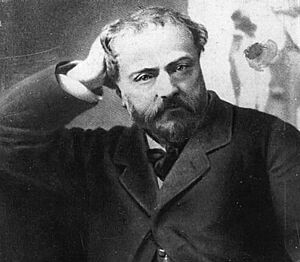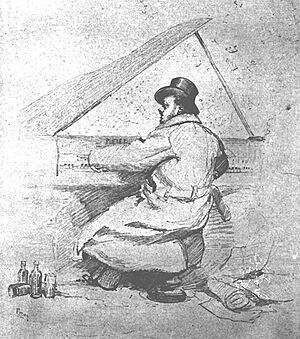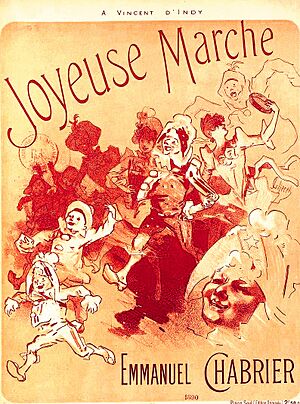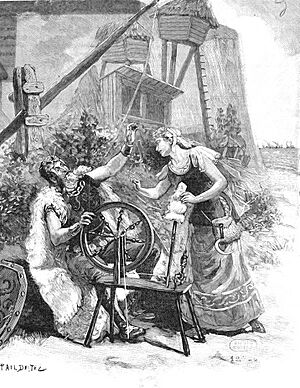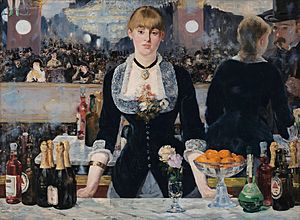Emmanuel Chabrier facts for kids
Emmanuel Chabrier (born January 18, 1841 – died September 13, 1894) was a French composer and pianist from the Romantic era. His family, who were well-off, did not want him to become a musician. So, he studied law in Paris and worked for the government until he was 39. In his free time, he enjoyed the exciting art scene in Paris and composed music. From 1880 until he became very ill, he worked as a full-time composer.
Chabrier is best known for two of his orchestral pieces, España and Joyeuse marche. But he also wrote many operas (like L'étoile), songs, and piano music. He didn't write symphonies, concertos, or religious music. Because he didn't have formal music training, he was free to create his own unique musical style. Many later composers saw him as an important and new thinker who helped shape French modern music. Composers like Debussy, Ravel, Richard Strauss, Satie, Stravinsky, and the group called Les Six admired and were influenced by him. At a time when French musicians often took sides for or against Wagner's music, Chabrier found a middle path. Sometimes he used ideas from Wagner, and other times he avoided them.
Chabrier was friends with important writers and painters of his time. One of his closest friends was the painter Édouard Manet. Chabrier collected Impressionist paintings long before they became popular. Many paintings from his collection, by artists he knew, are now in famous art museums around the world. He wrote many letters to his friends and colleagues, which give us a peek into his musical thoughts and his personality.
Chabrier died in Paris when he was 53 years old, due to a sickness that affected his brain.
Contents
Life Story of Emmanuel Chabrier
Early Years and Family Life

Emmanuel Chabrier was born in Ambert, a town in central France. He was the only son of Jean Chabrier, a lawyer, and his wife, Marie-Anne-Evelina. The Chabrier family had lived in the Auvergne region for a long time. They were originally farmers, but in recent generations, many became merchants and lawyers. A very important person in his home was his nanny, Anne Delayre, whom he called "Nanine." She remained close to him throughout his life.
Chabrier started music lessons when he was six. His first teachers were from different countries. In Ambert, he learned from a Spanish refugee. After his family moved to Clermont-Ferrand in 1852, he studied with a Polish musician, Alexander Tarnovsky. The earliest music Chabrier wrote that we still have are piano pieces from 1849.
Tarnovsky told Chabrier's parents that their son was talented enough to become a musician. However, Jean Chabrier wanted his son to follow him into law. So, in 1856, the family moved to Paris. Chabrier went to the Lycée Saint-Louis and then to law school. But he didn't stop studying music, continuing his lessons in composition, violin, and piano. After finishing law school in 1861, he started working for the French government at the Ministry of the Interior. He worked there for 19 years.
Balancing Music and Work in Paris
Chabrier was well-liked at his government job, but his true passion was music. He spent all his free time composing and studying. He continued lessons with teachers like Edouard Wolff (piano) and Théophile Semet (composition). A writer named Jacques-Gabriel Prod'homme said in 1935 that Chabrier wasn't just a hobby musician during this time. He was very interested in the "modern" art and literature of his day, which was unusual for musicians.
From 1862, Chabrier was part of a group of artists and writers in Paris called the Parnassians. He was friends with writers like Paul Verlaine. With Verlaine, he planned a funny opera in the style of Offenbach, called Vaucochard et fils Ier. He didn't finish it, but parts of it from around 1864 or 1865 still exist. His full-time job made it hard for him to write big musical works. He started an opera about a Hungarian historical theme called Jean Hunyade but stopped working on it in 1867. In 1872, he had a success with a short comic opera, Le Service obligatoire, which he wrote with two other composers. People who saw it said it clearly showed Chabrier's talent.
People often talked about Chabrier's piano playing. Years later, the composer Vincent d'Indy wrote that even though Chabrier's arms were short and his fingers thick, he played with great skill and feeling. The composer and critic Alfred Bruneau said Chabrier played the piano like no one else. The wife of the painter Pierre-Auguste Renoir, who was a friend of Chabrier, described him playing his famous piece España. She said it sounded like a hurricane, and he hit the keys so hard that he broke several piano strings!
Both of Chabrier's parents died in 1869. During the Franco-Prussian War (1870–1871), he continued his government job as the ministry moved from city to city. In 1873, he married Marie Alice Dejean. They had three sons, but one died at birth. Chabrier's friends in Paris included composers like Gabriel Fauré and Ernest Chausson, painters like Edgar Degas and Édouard Manet, and writers like Émile Zola.
In the 1870s, Chabrier started several stage works. The first one he finished was a three-act comic opera called L'étoile (The Star) in 1877. It was a modest success, playing 48 times. This opera helped him get noticed by the press and a publishing company. Most importantly, after L'étoile, he was no longer seen as just a talented amateur.
Becoming a Full-Time Composer

Like many French composers of his time, Chabrier was very interested in Wagner's music. When he was young, he copied the entire score of Wagner's opera Tannhäuser to understand how Wagner composed. In March 1880, Chabrier went to Munich with friends to see Wagner's opera Tristan und Isolde for the first time. He was so moved by the music that he cried. He later said he had waited ten years to hear that music.
This experience made Chabrier decide to focus only on being a composer. He left his government job in late 1880. Some historians believe other things also influenced his decision, like his growing music career and the first signs of a nervous illness that would later take his life.
Chabrier had started working on a serious opera called Gwendoline in 1879. The writer for this opera was Catulle Mendès. Many people later said the story for Gwendoline was not very good. Chabrier worked on this opera until 1885.
The conductor Charles Lamoureux hired Chabrier as his chorus master and rehearsal coach. Lamoureux also included Chabrier's music in his orchestra's concerts. In 1881, Chabrier's piano pieces called Pièces pittoresques were first performed. The famous composer César Franck said, "We have just heard something extraordinary: this music links our time with that of Couperin and Rameau".
In 1882, Chabrier and his wife visited Spain. This trip led to his most famous work, España (1883). It mixes popular Spanish tunes he heard with his own original melodies. It was first performed in November 1883 and was an instant, huge success. It made Chabrier famous and was played many times because people loved it.
The Paris Opéra did not want to perform Gwendoline. It was first performed in Brussels in 1886. It was well-received, but the theater went bankrupt after only two performances. While trying to get his opera staged, Chabrier also wrote some of his important songs, like "Tes yeux bleus" and "Chanson pour Jeanne." He then found a new opera project, Le roi malgré lui (The King in Spite of Himself), and finished it in six months. It was first performed in Paris and seemed to be a success, but the theater burned down after the third show.
Because Chabrier was friends with a Belgian singer and a conductor, opera houses in Germany became interested in his works. Chabrier made several happy trips to Germany, where his music was performed in seven cities. In July 1888, he was honored with the Chevalier de la Légion d'honneur award.
Chabrier wrote many lively letters. People say his letters show his natural way of expressing himself, often using funny and informal language. In 1994, a huge collection of his letters was published, showing his thoughts on music, his talks with friends, and even a letter to his son about a pet bird.
Later Years and Health Challenges
In his last years, Chabrier faced money troubles because his bankers failed. He also suffered from declining health and sadness because his stage works were not often performed in France. The death of his beloved "Nanine" in January 1891 deeply affected him. In 1892, he wrote to a friend, "Never has an artist loved music more, tried to honor it more than me, none has suffered more from it; and I will go on suffering from it forever."
He became very focused on writing his last opera, Briséïs, which was inspired by a story by Goethe and had some musical echoes of Wagner. He only finished one act. The first performance of Gwendoline in Paris finally happened in December 1893. Chabrier, who was very ill both physically and mentally, sat in a theater box with his family. He enjoyed the music but didn't realize he had written it, nor did he understand that the applause was for him.
Chabrier died in Paris at 53 years old from a serious illness that affected his brain. He had asked to be buried near his friend Manet, but a spot wasn't available. He was buried in the Montparnasse Cemetery. His wife and children also suffered from health problems. His wife had severe eye issues and became almost blind, and later could not move her legs. She died at 51. His eldest son, Marcel, died at 35 with similar symptoms, and his youngest son, André, also became unable to move his legs and died at 35.
Chabrier's Musical Works
The music expert Denis Arnold said that Chabrier's lack of formal music school training allowed him to create his own unique musical style. He explored new harmonies and ways of writing for the piano. Chabrier's music often used melodies with big jumps between notes, and he frequently doubled melodies in the bass or in octaves. He also mixed traditional and new harmonies, and often used tricky rhythms. Chabrier reportedly said, "My music rings with the stamp of my Auvergnat clogs," meaning it had a strong, earthy, French feel.
Orchestral Music
Some composers had doubts about Chabrier's skill in writing for orchestras in his early works. However, the composer Francis Poulenc disagreed, believing Chabrier was a master of orchestration from the start. Poulenc wrote that even though Chabrier composed at the piano, he found a unique sound for his orchestra.
Chabrier's most famous work is his rhapsody España, which became popular worldwide. The lively rhythm of España is also found in his Joyeuse marche, which shows even more creative orchestral ideas. Not all of Chabrier's orchestral pieces are so energetic; his Lamento (1874) is a very sad and touching work.
Some of Chabrier's piano pieces were later arranged for orchestra. He arranged four movements from his Pièces pittoresques into the Suite pastorale. His friend Felix Mottl also arranged Bourrée fantasque for orchestra in 1898, which became very popular.
Stage Works (Operas)
Chabrier's lively orchestral works have always been popular. However, there's less agreement about his serious operas, especially how much they were influenced by Wagner. Some critics felt that Wagner's style didn't mix well with French music. Others argued that Chabrier changed Wagner's ideas so much that his music sounded completely original.
L'étoile (The Star), a comic opera from 1877, was Chabrier's first successful opera and is still performed today. Even though the story is a bit confusing, the words were well-written and funny. The music is light and charming, like the best comic operas of Offenbach.
Une éducation manquée (An Incomplete Education), a one-act comic opera about a young couple seeking wedding advice, was performed privately in 1879 but not publicly until 1913. Critics wonder why this charming little work took so long to be heard by the public. The story is handled very gently, and the music is enchanting.
Chabrier's only finished serious opera was Gwendoline, written between 1879 and 1885. It premiered in 1886. Many people felt the story was a weakness. However, some experts say the music is less like Wagner than people think and has Chabrier's own unique style. The opera has been performed sometimes but hasn't become a regular part of opera shows.
Some of Chabrier's best music is in his comic opera Le Roi malgré lui (The King in Spite of Himself), from 1887. The story is very complicated and hard to understand. However, the composer Ravel loved this piece so much that he said he would rather have written it than Wagner's entire Ring cycle.
Chabrier's last opera was Briséïs. He was very ill and could only finish the first of three acts. The existing act is rarely performed, but a recording exists. Some thought the music of Briséïs showed how great Chabrier could have become if he had lived longer.
Piano Music
Even though Chabrier's piano works are not his most famous, some experts like Poulenc believe his Pièces pittoresques are as important for French music as Debussy's Preludes. The music expert Roy Howat says that Chabrier, more than any other composer, brought back important French qualities to music, like clarity, energy, humor, and tenderness.
Chabrier's early works were for solo piano. Most of his piano pieces were published during his lifetime. Some of his piano works are better known in their orchestral versions, like the Joyeuse marche and the four pieces from Pièces pittoresques that make up the Suite pastorale. His trip to Spain, which inspired España, also gave him ideas for a Habanera (1885), which became one of his most popular piano pieces.
Among Chabrier's works for four hands (two people playing one piano) is Souvenirs de Munich. Even though Wagner's Tristan und Isolde deeply impressed him, Chabrier's playful nature led him to arrange five themes from the opera into a funny dance. Poulenc called it "irresistibly funny."
Vincent d'Indy described playing Chabrier's Trois valses romantiques with the composer. Chabrier told him he was playing it too formally, like a "Member of the Institute!" He then showed d'Indy how to play "alla Chabrier," with unexpected accents, very soft parts, sudden loud bursts, and even using his body to express the music.
Chabrier greatly influenced Debussy, and later Ravel and Poulenc. Howat notes that Chabrier's piano music explored new sounds that Debussy used effectively 30 years later.
Songs
Chabrier published 43 songs. He started writing songs when he was about 21. It's interesting that he never set any poems by his friend Verlaine, but he did use verses by famous poets like Théodore de Banville.
In 1888, Chabrier arranged 16 French folk songs for a collection. He was one of the first important composers to work with folk songs, paving the way for composers like Ravel and Bartók. His folk song arrangements are light and simple, but the piano parts add a lot to their charm. A later group of songs (1889) had a funny theme about a "poultry farm," with lyrics about fat turkeys, little ducklings, and chirping cicadas.
Most of his songs are for a single voice and piano. However, there is one duet and one song, "L'invitation au voyage" (1870), where a solo bassoon joins the voice and piano. Chabrier's last song, "Ode à la Musique", is for a solo soprano, piano, and a female choir.
Chabrier's Influence on Music
The music expert David Charlton said that while other composers of his time simply combined existing musical styles, Chabrier's music was like a "catalyst." It helped create French modernism.
Debussy, Ravel, and Poulenc all said Chabrier influenced their music. Debussy wrote in 1893, "Chabrier, Moussorgsky, Palestrina, voilà ce que j'aime" (they are what I love). He also said he couldn't have written one of his pieces without Chabrier's La sulamite as an example. The influence on Ravel is even clearer. A study from 1975 said that few of Ravel's works don't somehow echo Chabrier's music. Ravel even paid tribute to Chabrier in his piece A la manière de Chabrier.
Poulenc said he thought of L'étoile when he wrote one of his own operas. Chabrier's influence on Poulenc and the other members of Les Six was very strong. These later composers were often drawn to the funny and playful side of Chabrier's music. Other French composers influenced by Chabrier include Charles Lecocq and Satie.
Composers from other countries also showed Chabrier's influence. Stravinsky's Petrushka has themes and melodies that remind us of Chabrier. Mahler called España "the beginnings of modern music." Richard Strauss, who admired Chabrier, conducted the first performance of the one act of Briséïs. Some critics believe Strauss was influenced by this work when he composed his opera Salome eight years later.
Chabrier and Art

Chabrier was known for being friends with many artists, especially Impressionist painters. He owned a wonderful collection of paintings by French artists of his time. A sale of his collection in 1896 included works by Cézanne, Manet, Monet, Renoir, and Sisley.
Chabrier himself was often painted or sketched by his artist friends. Two of these portraits are shown here: a drawing of Chabrier at the piano (1887) by Édouard Detaille and Manet's Portrait of Chabrier (1881). He is also seen at the piano in Autour du piano by Henri Fantin-Latour. Other portraits of Chabrier include a drawing by James Tissot (1861) and a bust by Constantin Meunier (1886).
Even though Chabrier had money worries, he saw his art collection as a "spiritual necessity" rather than just something valuable. He also collected writings by new and exciting authors of his time.
|


